Segundo a AMD, esta foi impedida de aceder ao código de jogo do Watch Dogs, que usa o Game Works da nVidia. Por causa disto a AMD ficou impossibilidade de optimizar as suas drivers de forma adequada para o jogo, resultando num desempenho abaixo do esperado. Pelos vistos temos aqui mais uma telenovela entre os dois grandes do mercado gráfico e ainda deve correr muita tinta e acusações antes de terminar.
http://techreport.com/news/26515/amd...eworks-program
Mas segundo a nVidia, esta nunca impediu ninguém de aceder a jogos para optimizar as suas drivers. Ainda por cima, acusa a AMD de ter bloqueado o acesso a alguns jogos quando a nVidia precisava de optimiar as suas drivers.Is Nvidia unfairly pushing developers not to optimize their games for AMD hardware? That's the allegation made this weekend in a story by Forbes contributor Jason Evangelho. The story quotes Robert Hallock, technical communications lead for PC graphics at AMD. Hallock uses some pretty strong words to talk about GameWorks, Nvidia's programming toolkit and developer relations package:Gameworks represents a clear and present threat to gamers by deliberately crippling performance on AMD products (40% of the market) to widen the margin in favor of NVIDIA products. . . . Participation in the Gameworks program often precludes the developer from accepting AMD suggestions that would improve performance directly in the game code—the most desirable form of optimization.Hallock also alleges that "code obfuscation" stemming from GameWorks integration prevents AMD from adequately optimizing its drivers for some games. "[T]he characteristics of the game are hidden behind many layers of circuitous and non-obvious routines," he explains, adding that Nvidia has removed "all public Direct3D code samples from their site in favor of a 'contact us for licensing' page."
Ubisoft's Watch Dogs, which comes out today, is cited as a particularly stark example of unequal optimization. "It's evident that Watch Dogs is optimized for Nvidia hardware," Evangelho writes in his story, "but it's staggering just how un-optimized it is on AMD hardware." Evangelho also links an older article by ExtremeTech. That article made a similar observation about Batman: Arkham Origins, and it similarly pinned the blame on GameWorks.
We've seen in our own testing how AMD graphics cards can underperform in some GameWorks-enabled games, including Batman: Arkham Origins and Assassin's Creed IV: Black Flag, so Evangelho likely isn't wrong there. For whatever reason, some GameWorks titles do seem to run poorly on Radeons.
Curiously, however, Evangelho's story includes no statement from Nvidia—nor does it indicate that Nvidia was asked to comment. The story also makes some odd claims. It asserts, for example, that AMD's Mantle API "doesn't require" AMD graphics hardware to function and "will work equally well on Nvidia cards." (AMD told me at GDC that, with DirectX 12 now on the horizon, we're "probably not going to see" Mantle on Nvidia hardware.) Evangelho cites Mantle's purported vendor-agnosticism as evidence that AMD "clearly waves a banner of open-source development and ideals."
We've asked Nvidia to comment, and we're currently awaiting a response from the company. For what it's worth, though, a former Nvidia software engineer, John McDonald, sounded off on Twitter yesterday about this story. He wrote:It is extremely frustrating to see an article criticizing work you did at a former employer and not being able to comment that the person who you are quoting from was just completely full of unsubstantiated [expletive]. Thanks, Forbes. . . . [A]nd while I never did, and certainly do not now, speak for nvidia, let me say that in the six years I was in devtech I *never*, not a single time, asked a developer to deny title access to AMD or to remove things that were beneficial to AMD.
http://techreport.com/news/26521/nvi...ks-allegations
Earlier today, I spoke with Cem Cebenoyan, Director of Engineering for Developer Technology at Nvidia, who offered a rebuttal to a Forbes story we covered yesterday. In that story, AMD's Robert Hallock alleged that Nvidia's GameWorks program prevents AMD from working with game developers on GPU optimizations.
According to Cebenoyan, Hallock's claims are baseless. "It's definitely not true. We've never done anything like that, where we preclude people from working with our competition or taking suggestions from our competition or getting access to builds," Cebenoyan told me. "I don't know the specifics, because it's not really our business as to who has access to our games developers partners' builds. That's up to them, right? But my assumption is . . . all the competitors have equal access in terms of getting builds."
By builds, Cebenoyan meant pre-release game builds, which developers normally share with GPU manufacturers prior to launch. Nothing in the GameWorks licensing terms precludes that type of collaboration, Cebenoyan said. The terms do, however, forbid developers from sharing Nvidia's GameWorks middleware code—which, when that code is integrated into a game engine, may mean AMD doesn't get access to that portion of a game's source code.
As I understand it, these licensing terms are new. They've only been in place since March or so, coinciding with the release of GameWorks 2014. Prior to that, Nvidia's collaboration with developers on middleware was "ad hoc."
Cebenoyan conceded that AMD is "concerned" about not having the code for Nvidia's GameWorks modules. However, he seems to believe that shouldn't hinder AMD's optimization efforts. "Historically, in all the games we've worked with, we don't typically need the source code to a game to optimize for it," he told me. "We don't typically have the source code to most games. Our driver engineers typically—actually almost never have looked game source code. So that's not really the operating model."
I asked whether, prior to the establishment of the GameWorks licensing model, AMD would have had access to the code for games with Nvidia middleware. "No, I don't think so," Cebenoyan replied. "In general, most game developers don't really give people source code, anyway."
Addressing AMD's specific complaint about code samples disappearing from Nvidia's website, Cebenoyan pointed out that the samples are still there. "Someone just failed in navigating the website," he said. The samples can be downloaded here, and Nvidia doesn't intend to remove them; indeed, the company says it wants to add more of them.
Of course, those samples shouldn't be confused with Nvidia's proprietary GameWorks modules, which aren't available to the public. (According to Cebenoyan, GameWorks modules are bona-fide middleware. "There's all kinds of things—software engineering type things—that go into building something that's a real piece of middleware that is not what you worry about when you just have a sample," he said.)
So, if GameWorks isn't the problem, then why do certain Nvidia-backed titles (such as Assassin's Creed IV: Black Flag, Arkham Asylum, and Watch Dogs) perform so comparatively poorly on AMD hardware? Nvidia's PR team butted in there, hinting that AMD's developer relations efforts are thinly spread. Considering AMD's ongoing financial hurdles, that's not outside the realm of possibility.
Cebenoyan then chimed in, "We spend a lot of energy on those titles. We really look at them carefully and try to make the experience as good as possible for Nvidia customers. Maybe in the process of doing that, that makes it so that it's noticeably better than on AMD. I don't know. But it's not a functional way to work with developers where you suggest things to them that hurt a significant portion of their user base. That's just not gonna fly with any competent developer. So that's not something that we ever do."
Somewhat contradictorily, Cebenoyan went on to tell me that, in "at least" two instances, AMD's own developer relations efforts impeded Nvidia's work with game developers. "We know of real examples where we have actually explicitly been forbidden from seeing builds—forget source code, even just binary builds—of games that include high-end effects," Cebenoyan said. "The full game with all of the effects, the important PC ultra quality settings, [was] hidden from us until say a few weeks before launch, something like that. These were things that were contractually obligated."
Cebenoyan wouldn't name names, but his description sounded an awful lot like the allegations Nvidia made after Tomb Raider came out last year. Cebenoyan doesn't think the developers set out to disenfranchise Nvidia users willingly. Rather, he blames a hidden clause in their contract with AMD.
For what it's worth, AMD has denied that its Gaming Evolved program involves such clauses. The program "undertakes no efforts to prevent our competition from optimizing for games before their release," the company stated last June.
So, yeah. We're looking at some very similar allegations from both Nvidia and AMD—and, in both cases, emphatic denials of wrongdoing.
Without talking to developers, it's hard to know for sure exactly what all those licensing agreements and contracts stipulate, either explicitly or implicitly. That said, it's possible that there's some truth to what both companies are saying. The world of PC gaming hardware is a highly competitive one, and bending the rules of fair play even slightly can pay some very real dividends.
User Tag List
 Likes: 0
Likes: 0
Resultados 1 a 15 de 24
-
29-05-14, 10:29 #1Moderador


- Registo
- Feb 2013
- Local
- Santo Tirso
- Posts
- 12,674
- Likes (Dados)
- 30
- Likes (Recebidos)
- 208
- Avaliação
- 4 (100%)
- Mentioned
- 7 Post(s)
- Tagged
- 0 Thread(s)
AMD acusa a nVidia de jogo sujo com o GameWorks
-
29-05-14, 12:16 #2O Administrador


- Registo
- Mar 2013
- Local
- Multiverso
- Posts
- 17,815
- Likes (Dados)
- 74
- Likes (Recebidos)
- 156
- Avaliação
- 31 (100%)
- Mentioned
- 31 Post(s)
- Tagged
- 0 Thread(s)
Boas!
Isto não é novidade para ninguém...
São conhecidas as movimentações á lá INTEL da Nvidia, usando tecnologia proprietária, fechando acessos a códigos fonte, etc...
Acredito que tal como a AMD diz, não lhe foi fornecido qualquer acesso ao código do jogo, pelo que se o mesmo usar configurações diferentes do set Standard do DirectX, a AMD não tem forma de saber o que foi feito!
A Nvidia é um mau player no mercado, que tal como a Intel, usa e abusa da sua posição para prejudicar o consumidor (e apenas e só para agradar os seus accionistas).
No entanto verdade seja dita, o jogo não é nada de especial e a AMD tem do seu lado muito melhores players que a NVIDIA... O mantle será a prova disso em breve...
Cumprimentos,
LPCMy Specs: .....

CPU: AMD Ryzen 7 5800X3D :-: Board: MSI B550M BAZOOKA :-: RAM: 64 GB DDR4 Kingston Fury Renegade 3600 Mhz CL16 :-: Storage: Kingston NV2 NVMe 2 TB + Kingston NV2 NVMe 1 TB
CPU Cooling Solution: ThermalRight Frost Commander 140 Black + ThermalRight TL-C12B-S 12CM PWM + ThermalRight TL-C14C-S 14CM PWM :-: PSU: Corsair HX 1200 WATTS
Case: NZXT H6 FLOW :-: Internal Cooling: 4x ThermalRight TL-C12B-S 12CM PWM + 4x ThermalRight TL-C14C-S 14CM PWM
GPU: ASUS TUF AMD RADEON RX 7900 XTX - 24 GB :-: Monitor: BenQ EW3270U 4K HDR
-
29-05-14, 12:34 #3Tech Ubër-Dominus


- Registo
- Mar 2013
- Posts
- 12,504
- Likes (Dados)
- 0
- Likes (Recebidos)
- 1
- Avaliação
- 18 (95%)
- Mentioned
- 0 Post(s)
- Tagged
- 0 Thread(s)
Boas,
O que a AMD tem de seu lado é as consolas serem AMD, isso sim é algo a seu favor e a favor dos ports das consolas para PC... vamos a ver ports Intel e aquilo é uma banhada total diga-se de passagem.Fractal Define Mini | i5 3570k@4.5GHz & Noctua NH-D15S | Asrock Z77 Pro4-M | Gigabyte GeForce GTX 1060 G1 6GB | Kingston HyperX Fury 16GB 1866 | 3TB + Samsung 850 250GB | SuperFlower Leadex 750W GOLD | Creative Sound Blaster Z
-
29-05-14, 13:13 #4O Administrador


- Registo
- Mar 2013
- Local
- Multiverso
- Posts
- 17,815
- Likes (Dados)
- 74
- Likes (Recebidos)
- 156
- Avaliação
- 31 (100%)
- Mentioned
- 31 Post(s)
- Tagged
- 0 Thread(s)
Boas!
Ports Intel?
A AMD ganhou a corrida ás consolas, de forma limpa, a Nvidia na sua eterna arrogância, disse que o mercado de consolas não lhes rendia para fazer os Gpus...
Todos sabemos que é bullshit, já que a NVIDIA não tem APU´s nem tem a licença para fabricar a tecnologia X86 necessária para correr de forma rápida as aplicações baseada nessa arquitectura.
No fundo isto é uma forma agressiva de tentar prejudicar a AMD...
O que eles se esquecem é que quem é AMD um dia pode ser Nvidia e o oposto é igual... Ao prejudicarem os consumidores apenas se queimam a eles próprios...
Ou pensam que lançar Titans Z a 3000 dólares os vai salvar...
Por estas e por outras é que eu por uma questão de consciência não usaria produtos dessa empresa... A mesma mostra bem o que se interessa pelos consumidores...
Cumprimentos,
LPCMy Specs: .....

CPU: AMD Ryzen 7 5800X3D :-: Board: MSI B550M BAZOOKA :-: RAM: 64 GB DDR4 Kingston Fury Renegade 3600 Mhz CL16 :-: Storage: Kingston NV2 NVMe 2 TB + Kingston NV2 NVMe 1 TB
CPU Cooling Solution: ThermalRight Frost Commander 140 Black + ThermalRight TL-C12B-S 12CM PWM + ThermalRight TL-C14C-S 14CM PWM :-: PSU: Corsair HX 1200 WATTS
Case: NZXT H6 FLOW :-: Internal Cooling: 4x ThermalRight TL-C12B-S 12CM PWM + 4x ThermalRight TL-C14C-S 14CM PWM
GPU: ASUS TUF AMD RADEON RX 7900 XTX - 24 GB :-: Monitor: BenQ EW3270U 4K HDR
-
29-05-14, 13:37 #5Tech Mestre


- Registo
- Feb 2013
- Posts
- 6,568
- Likes (Dados)
- 0
- Likes (Recebidos)
- 8
- Avaliação
- 3 (100%)
- Mentioned
- 3 Post(s)
- Tagged
- 0 Thread(s)
A Nvidia é bem capaz de fazer este tipo de coisas, tal como a Intel. A AMD não as faz porque não está numa posição que lhes permita esse tipo de atitudes, mas caso qualquer dia venha a poder, não duvidem que o fará também. São tudo empresas, todas elas capitalistas. Não pensem que a AMD é a boazinha, é tudo farinha do mesmo saco.
-
29-05-14, 13:54 #6Moderador


- Registo
- Feb 2013
- Local
- Santo Tirso
- Posts
- 12,674
- Likes (Dados)
- 30
- Likes (Recebidos)
- 208
- Avaliação
- 4 (100%)
- Mentioned
- 7 Post(s)
- Tagged
- 0 Thread(s)
Por acaso a AMD fez isso recentemente com o Tomb Raider. A nVidia demorou quase um mês após o lançamento do jogo a ter drivers optimizadas.
O problema é que com estas aldrabices, tanto da AMD, como da nVidia, como da Intel, quem se lixa sempre são os consumidores pois independentemente de que marca tenham, a certa altura vão ter um desempenho inferior do que o normal.
-
29-05-14, 19:13 #7Tech Ubër-Dominus


- Registo
- Mar 2013
- Posts
- 12,504
- Likes (Dados)
- 0
- Likes (Recebidos)
- 1
- Avaliação
- 18 (95%)
- Mentioned
- 0 Post(s)
- Tagged
- 0 Thread(s)
Grid é um verdadeiro exemplo para Intel, a diferença para cpu AMD era bem notória.
Enviado do meu C1505 através de TapatalkFractal Define Mini | i5 3570k@4.5GHz & Noctua NH-D15S | Asrock Z77 Pro4-M | Gigabyte GeForce GTX 1060 G1 6GB | Kingston HyperX Fury 16GB 1866 | 3TB + Samsung 850 250GB | SuperFlower Leadex 750W GOLD | Creative Sound Blaster Z
-
26-06-14, 12:36 #8Tech Veterano


- Registo
- Mar 2013
- Local
- Rua do "Rijo"
- Posts
- 4,581
- Likes (Dados)
- 0
- Likes (Recebidos)
- 0
- Avaliação
- 1 (100%)
- Mentioned
- 0 Post(s)
- Tagged
- 0 Thread(s)
Guerra entre Nvidia e AMD sobe de tom e baíxa de nivél
isto já parece uma birra de putos da primária mas pronto ... LOLA guerra entre os fabricantes de GPUs Nvidia e AMD está a subir de tom e a baixar de nível. Tudo começou quando no ano passado Robert Hallock da AMD lançou acusações relativas ao Gameworks, que afirmou "representar uma clara ameaça para os gamers, ao deliberadamente baixar a performance em produtos AMD (40 porcento no mercado), para aumentar a margem em favor dos produtos Nvidia.
A parceria Nvidia Gameworks envolve uma grande quantidade de jogos, que teoricamente são optimizados para as gráficas da Nvidia. Mas agora foi a AMD a anunciar uma lista de de parcerias de desenvolvimento que inclui títulos como Battlefield: Hardline, Dragon Age: Inquisition, Civilization: Beyond Earth e Star Citizen.
A Nvidia respondeu dizendo que "seria impossível manter a lista actual de parcerias", tendo em conta o enorme alcance do programa.
Em conversa com o Kotaku, um representante da Nvidia afirmou que - "Se a AMD gastasse o mesmo tempo a actualizar as suas drivers e a fazer investimentos em gaming, que o tempo que passam a falar sobre nós, então, talvez os seus clientes não tivessem que aturar experiências de jogo abaixo do normal, nos títulos de topo de hoje."

-
26-06-14, 14:40 #9Tech Membro


- Registo
- Mar 2013
- Local
- C.Branco
- Posts
- 2,326
- Likes (Dados)
- 0
- Likes (Recebidos)
- 0
- Avaliação
- 0
- Mentioned
- 0 Post(s)
- Tagged
- 0 Thread(s)
Essa afirmação da nVidia ou está mal traduzida ou é um bocado parola... investimento em gaming tem sido coisa que não tem faltado à AMD. Mantle só por si já foi responsável por mudar o paradigma das API, especialmente o DX12. Não é por acaso que um terço das editoras na actual beta do Mantle se envolveram para terem uma espécie de "preview" do que vai ser o DX12 mais tarde. Até a Intel já pediu à AMD para dar uma vista de olhos. Se a AMD não "gastou tempo" e "investimento" no Mantle, tal como a nVidia diz, então parabéns à AMD porque acabou de fazer um milagre sem mexer uma palha nem gastar um pataco (y, right...). Depois há Freesync, embora com muito menos investimento necessário, adoptado pela VESA no DisplayPort 1.3a, etc...
And btw, o facto da AMD ter mais jogos a caminho com Mantle não quer dizer muito nesta "batalha", os jogos continuam a ter DX e Mantle ao mesmo tempo, simplesmente correrá melhor na opção Mantle (especialmente hardware mais fraco). E se tiverem TressFX, então a nVidia não ter problemas com isso porque já tem maneira de o optimizar nas nVidia.
O problema da nVidia é que faz investimentos com objectivo de evelado "€xploit", enquanto a AMD os faz mais com objectivo principal de avançar a indústria e de forma aberta. E quando a coisa não corre tão bem para nVidia (G-Sync, Shield,...), digamos que não ficam tão bem na fotografia, especialmente considerando o marketing e royalties que esperam obter... A situação do Gameworks e seus ".dll", embora vá prevalecer, revela um caminho menos bom para a indústria, mas revela também o que a nVidia tem que fazer para se fazer notar (em termos de tech, porque em termos de market share está em melhor posição) num mercado actual que se está a modificar.
-
31-07-14, 16:20 #10Moderador


- Registo
- Feb 2013
- Local
- Santo Tirso
- Posts
- 12,674
- Likes (Dados)
- 30
- Likes (Recebidos)
- 208
- Avaliação
- 4 (100%)
- Mentioned
- 7 Post(s)
- Tagged
- 0 Thread(s)
A resposta da nVidia:
Ryzen R5 3700X / Noctua NH-D15 / B550 AORUS ELITE V2 / Cooler Master H500 Mesh / 16Gb DDR4 @ 3800mhz CL16 / Gigabyte RTX 2070 Super / Seasonic Focus GX 750W / Sabrent Q Rocket 2 TB / Crucial MX300 500Gb + Samsung 250Evo 500Gb / Edifier R1700BT
-
28-07-15, 15:01 #11Tech Ubër-Dominus


- Registo
- Nov 2013
- Local
- City 17
- Posts
- 30,121
- Likes (Dados)
- 0
- Likes (Recebidos)
- 2
- Avaliação
- 1 (100%)
- Mentioned
- 0 Post(s)
- Tagged
- 0 Thread(s)
Exclusive : Both Nvidia And AMD Sides of The GameWorks Story – Addressing Misconceptions And Getting To The Bottom Of The Issue Part 1
For this story we engaged with Nvidia and AMD to hear both sides of the GameWorks debate and get to the bottom of the issue. And I’m quite pleased to say that both parties were very receptive. There’s been a lot of confusion, a lot of hearsay, misconceptions and mischaracterizations around several aspects of this vital issue that we mean to address head-on today. And with the help of both Nvidia and AMD we’re hoping that we will come out with a clear understanding of both perspectives at either end of the discussion table and perhaps even find common ground from which potential solutions can spawn.

We should start by explaining what GameWorks is and the motivations that had sparked its creation.
What GameWorks Is And Why It Exists
GameWorks is a developer program set-up by Nvidia to provide game developers with a collection of graphics libraries and tools aimed at improving the visual quality of games. It includes technologies such as PhysX – Nvidia’s proprietary physics engine – as well as VisualFX which encompasses a number of Nvidia optimized rendering techniques and in-game visual effects. These include things like shadows, anti-aliasing, depth of field, global illumination, hair simulation, ambient occlusion, lighting and other effects.
Below you will find the VisualFX solutions as listed on Nvidia’s website.
VisualFX provides solutions for rendering and effects including:
- HBAO+ Enhanced Horizon Based Ambient Occlusion
- TXAA Temporal Anti-aliasing
- Soft Shadows Improves on PCSS to reach new levels of quality and performance, with the ability to render cascaded shadow maps
- Depth of Field Combination of diffusion based DOF and a fixed cost constant size bokeh effect
- FaceWorks Library for implementing high-quality skin and eye shading
- WaveWorks Cinematic-quality ocean simulation for interactive applications
- HairWorks Enabling simulation and rendering of fur, hair and anything with fibers
- GI Works Adding Global Illumination greatly improves the realism of the rendered image
- Turbulence High definition smoke and fog with physical interaction as well as supernatural effects
Nvidia told us about several motivations which formed the primary driving force behind the development of the GameWorks program. For starters the program would allow the company to both widen its scope of reach and speed up the adoption rate of its technologies. The company had grown frustrated from how slowly things moved and it had to accelerate the turnover of its investment in this field. Faster and wider adoption means that more games can leverage more of Nvidia’s tech. This in turn translates to the creation of more games where the company can positively influence both the performance and the visuals to offer users of its latest GeForce products a better experience. But perhaps more importantly it gives the company a competitive advantage by which it can justify its investment.
We’re told that the rate of adoption was lacking because games had grown more complex and so had the visual effects and rendering techniques in these games. By offering developers the convenience of an easy to integrate dynamically linked library – essentially a middleware solution – that’s already optimized for Nvidia’s hardware, it can cut back tremendously on the development time and allow game developers to dedicate their resources to focus on other areas in their games.
The fact that Nvidia maintains tight quality control measures over its GameWorks libraries means that it can guarantee the level of quality and performance of each feature once it’s in the game. It also means that the company can more quickly and readily update and iterate on each library to introduce better visuals and superior performance characteristics on a regular basis. This in turn gives Nvidia a more authoritative say in how the feature runs and looks in the game, after all it is its intellectual property.
This approach of providing game developers with ready-made effects in the form of DLLs as a middleware solution differs from the traditional approach that Nvidia has taken before GameWorks’ inception. And also differs from the approach that its competitors, namely Intel and AMD, continue to follow. The traditional approach involves supplying game developers with the source code of the feature so it can be implemented directly into the game rather than through a middle layer. The developers would have complete freedom over how the feature is implemented, they can look at the source code and make changes to it as they see fit. In this case the game developer would maintain the ultimate say in how their game looks, runs and more importantly how it’s optimized.
With the GameWorks program developers can gain access to source code through a licensing deal with Nvidia. However this means that developers are not allowed to share this code with anyone else without a license, this obviously includes Nvidia’s competitors like AMD and Intel.
However we’re told that game developers are still allowed to optimize GameWorks features for competitors’ hardware without showing it to them and as long as it does not negatively impact the performance of Nvidia hardware.
This is inherently different from the industry standard approach discussed earlier, where the developer not the hardware vendor – in this case NVIDIA – gets to decide who can and cannot see the code and what they can do to it. It brings us back to the earlier point about how GameWorks enables Nvidia to have a more authoritative say in the game’s performance.
I also have to point out an important distinction here between a regular GameWorks-developer partnership and a source license. By default Nvidia provides GameWorks features in binary only builds without source code. The license to gain access to source code is not automatically given to Nvidia GameWorks partners and certainly not for free. If the developer wants access to the source code they have to specifically request a source license and are required to pay a fee. Unfortunately, Nvidia has not shared with us or any other publication what this fee is.
And this is where things get quite complicated and a few points of contention arise; both from AMD’s perspective and some game developers’ perspective. The first of which is that this puts some limits on the developers’ control over their game. Because it’s not their own code, rather it is Nvidia’s code that they’ve merely licensed. So they have to follow the guidelines set forth by the licensor. And this creates a different dynamic where some decisions – that would traditionally be made by the developer – would now be delegated to Nvidia instead.
“It’s not CD Projekt Red’s decision to allow the Nvidia tech to work on AMD GPUs – that is Nvidia’s decision and most commonly-used features from us are platform-agnostic. It’s the same for CPU-based PhysX and Clothworks as well.” Eurogamer.comClearly the implications of this beg a serious discussion and there were many questions that we wanted to ask both NVIDIA and AMD, so we talked to both. Let’s start with NVIDIA first. I’ve personally spent over an hour on the phone with NVIDIA’s head of PR for GameWorks, Brian Burke. He eagerly wanted to get on the phone to kick off this discussion and an hour long international call is nothing to sniff at. I’ve made sure to make mention of this because it just goes to show how important this debate truly is and how much it means to NVIDIA, so hats off to Brian for reaching out to us!
We discussed NVIDIA’s GameWorks developer program at length as well as some specifics with regards to its implementation in some games like The Witcher 3. But because the discussion had gone on for such a long time I followed up with Brian to distill it down to one digestible interview.
Interview with NVIDIA’s Brian BurkeWhat’s the difference between Nvidia’s The Way It’s Meant To Be Played sponsorship program and the GameWorks developer program ?In other words TWIMTBP is a marketing program through which game developers can partner with Nvidia to co-market their game. While GameWorks is a developer program through which NVIDIA can work with game developers to integrate its GameWorks IP – library of optimized visual effects – into the developers’ IP in this case video games.
TWIMTBP is our promise of a great gaming experience. GameWorks helps us achieve that promise. GameWorks encompasses all of the game-related technologies we’ve invented over the years, the graphics technologies and the tools to implement them that help game developers build better games. It is backed by over 300 visual effects engineers who develop libraries, developer tools, and samples, and who work closely with developers to help enhance their games.
Nvidia has managed to work with developers for years to implement technologies invented by Nvidia, for example HBAO and TXAA in Crysis 3, why does Nvidia see a need for the GameWorks program now ?This is what we had mentioned earlier with regards to games’ visual effects growing more complex and NVIDIA’s motiviation to speed up the rate of adoption of its IP.
We created GameWorks to advance gaming at a faster pace. To make games better, faster. Everyone at NVIDIA believes that great gaming hardware needs great gaming content. So we invest an enormous amount of our resources in making games better.
We used to just give out code samples for effects, and we still do. But as effects became increasingly more complex, just giving away code samples was not effective. It took too long to get the effects in to games and created work for developers. So we turned our library of special effects into a middleware solution. Productizing them into middleware is a more production-oriented approach to game effects. It makes integration easier and allows effects to be adopted by more developers more quickly, accelerating the pace of innovation in games.
Are game developers precluded from optimizing source code provided by Nvidia through the GameWorks program for non Nvidia hardware ?This is an important point to touch on. NVIDIA does not enforce any limitation, contractual or otherwise, on game developers’ ability to work with AMD to optimize their games. However because game developers’ are dealing with NVIDIA’s intellectual property it does exercise control over all GameWorks features and will always have the final say with regards to what can and cannot be done with any of the code it owns.
No. Our agreements with developers don’t prevent them from working with any other IHVs to optimize their game or any GameWorks features. GameWorks is a middleware, and like any other middleware we offer developers a source licensing. We provide source code, under license, to developers who request it. Licensees just can’t redistribute our source code to anyone who does not have a license.
If a developer requests source code for an Nvidia GameWorks feature, under license, and is then provided with source code, is that developer then free to edit that code as they see fit to optimize it for IHVs other than Nvidia ? assuming they don’t redistribute it.
Yes. As long as it does not lower performance on NVIDIA GPUs
Can you talk about some of the new GameWorks effects that Nvidia has in the pipeline and will be bringing out ?Again we wanted to make sure there was no ambiguity with regards to any sort of limitation that a GameWorks partnership would entail. The GameWorks program itself does not inherently preclude game developers from working with AMD to implement AMD specific technologies.
We can’t discuss unannounced stuff.
Does partaking in the GameWorks program preclude a game developer from working with AMD to implement an alternative to a specific GameWorks visual effect like HairWorks for example?
No. We don’t prohibit them from adding technologies from other IHVs to their games.
Are game developers, who partner with Nvidia to co-market their game, contractually obligated to use GameWorks code in their game ?
We want to market with games that offer the best gaming experience. Typically that means games with our tech inside. It’s not required.
A GameWorks partnership isn’t equivalent to an exclusive The Way Its Meant To Be Played co-marketing partnership for example. Where it is naturally expected that Nvidia technologies would exclusively be incorporated into the game. Or on the other end of the scale an exclusive AMD Gaming Evolved partnership, where tech from AMD would exclusively be incorporated into the game. GameWorks itself is an enablement tool, it could be used in a game that’s subject to an exclusive Nvidia co-marketing deal or equally end up in a game that is not.
What other methods besides editing source code can an IHV like yourself or your competitor use to optimize the performance of a specific in-game visual effect ?There are a couple of vitally important points that invite discussion here. The first is that Nvidia fully recognizes the importance of source code access and optimizing through source code. This is why the company, as discussed earlier, provides developers with the option of acquiring a source license to see and adjust source code. This is because Nvidia understands that there’s a lot that can be achieved through working directly with the source code itself. And undoubtedly improving and refining source code is often what yields the best results and leads to the most impactful performance improvements. Which is why it remains as one of the most desirable methods for optimizing performance in games and in fact it can sometimes be the only solution to the problem.
Advertisements
It is not impossible to optimize without source code. We don’t get source code for every game. But we still do a great job ensuring games run great on our platform as long as we have reasonable access to builds. Many developers don’t provide source code for their games to third parties, so we optimize games based on binary builds. We invest tens of millions of dollars annually in creating these technologies and it’s our intellectual property. We won’t share our IP with our competitors and I think that’s reasonable.
A great example of how important source code truly is would be the Tomb Raider reboot which launched last year. The game performed poorly on Nvidia hardware at launch, particularly so with TressFX Hair enabled which is AMD’s hair rendering and simulation technology similar to Nvidia’s more recent HairWorks feature.
The company laid the blame on not getting access to the final build of the game until very very close to launch. Which funnily enough is exactly the same issue AMD had with a number of GameWorks titles as well. Nvidia even issued a statement at the time saying that the performance issues cannot be completely resolved through a driver update and game code changes on the developer’s end would have to be made.
Please be advised that these issues cannot be completely resolved by an NVIDIA driver. The developer will need to make code changes on their end to fix the issues on GeForce GPUs as well. As a result, we recommend you do not play Tomb Raider until all of the above issues have been resolved.
Tomb raider was the first game to utilize AMD’s TressFX Hair – or any type of physical hair simulation technology – and Nvidia GPUs really struggled to run this DX11 Direct Compute based visual effect initially. This was not out of the ordinary as the compute heavy effect is expected to naturally run better on AMD GPUs which enjoy an inherit advantage in compute performance over equivalent Nvidia hardware, while Nvidia GPUs are inherently stronger in geometry. This is unsurprising as both AMD and Nvidia play to their respective hardware’s strengths with the graphics effects that they develop. We clearly see this with AMD’s compute based TressFX and with Nvidia’s tessellation based HairWorks.
That said GeForce GPUs were brought to parity with their respective Radeon equivalents in TressFX performance despite their compute deficit, no matter which team your graphics card was from running TressFX would have an identical performance impact. And it was achieved through a game patch with the necessary code changes to TressFX. Which goes to show how integral code is to the optimization process and the hurdles that it enables hardware vendors to overcome.
What also played a pivotal part in all of this is that AMD makes the source code for TressFX Hair – all of its developed visual effects – open and publicly available for anyone to download, see and use.
 AMD Developer Website
AMD Developer Website
No license is required to use and incorporate any of these AMD developed effects in-games. Which can’t be said for any of the GameWorks features.
 Nvidia Developer Website, GameWorks Section
Nvidia Developer Website, GameWorks Section
This open nature enables Nvidia to gain access to AMD code before it goes into any game via what’s publicly available and again once the code is in games because there’s no licensing involved, so the developers are free to share AMD’s code with Nvidia. And because these features are not packaged as a middleware solution they are integrated directly into games, so developers have full access to the source code to work with it and adjust it as they see fit.
With the Witcher 3 and HairWorks we saw nearly the exact same Tomb Raider scenario repeat itself with the roles reversed but with no similar success story in bringing the performance on both sides to parity. As mentioned earlier Nvidia played to its hardware’s strength with the tessellation based HairWorks feature so it was naturally expected that this effect would run better on Nvidia hardware. However what happened was very different from what we saw with TressFX.
A 13% performance advantage for Nvidia hardware in tessellation was turned to a 2X and 3X performance advantage running HairWorks. The game developers were not able to optimize the code for AMD nor was AMD able to even look at the code that’s running on its hardware.
“Many of you have asked us if AMD Radeon GPUs would be able to run NVIDIA’s HairWorks technology – the answer is yes! However, unsatisfactory performance may be experienced as the code of this feature cannot be optimized for AMD products. Radeon users are encouraged to disable NVIDIA HairWorks if the performance is below expectations.” CD Projekt Red’s Marcin MomotSo unlike TressFX where the feature performs the same on Nvidia and AMD hardware, HairWorks penalizes AMD hardware with double and up to triple the performance cost. In a statement issued to PCPer.com, Brian Burke stated that this was because of AMD’s tessellation performance. As we’ve noted earlier in the story it’s been historically well known that geometry performance has been one of Nvidia’s GPU architectures’ strong suits. Conversely AMD’s GPU architectures enjoy a similar lead in compute performance.
“It’s not CD Projekt Red’s decision to allow the Nvidia tech to work on AMD GPUs – that is Nvidia’s decision and most commonly-used features from us are platform-agnostic. It’s the same for CPU-based PhysX and Clothworks as well.” Eurogamer.com
So we initially believed that what Brian had told PCPer was the intuitive thing to say. But seeing as how performance parity was achieved on the compute heavy TressFX despite Nvidia’s inherit disadvantage at compute we were puzzled. A performance penalty running HairWorks that’s two to three times as worse on the AMD side vs the Nvidia side stroke us as bizarre despite the inherent tessellation advantage in Nvidia’s favor and our initial impression meant that we wanted to investigate further.
We started off by looking at two evenly priced graphics cards, we landed on the $200 price point with Nvidia’s GTX 960 and AMD’s R9 285. We should point out that since then AMD replaced the R9 285 with the faster R9 380 but for all intents and purposes they’re architecturally identical. We looked at Metro Last Light with tessellation set to max as well as the very tessellation intensive Unigine Heaven 4.0 test with tessellation also set to max and finally we looked at a pure tessellation synthetic benchmark which was Tessmark. We tested both cards at the extreme setting, factor x32, which is what we have found to be the default setting for HairWorks in the Witcher 3.






In our investigation we found that across a sample of Tessellation heavy games and benchmarks that the AMD Radeon R9 285 was either ahead of the Nvidia GeForce GTX 960 or at most 13% behind. Seeing as how Tessellation x32 is what’s used for HairWorks we were anticipating a similar 13% delta between the R9 285 and GTX 960.
But what we have found with HairWorks is that the performance cost on the R9 285 is double that of the Nvidia GPUs and it’s nearly three times for the R9 290X. If AMD’s tessellation performance was the real reason behind this huge penalty running HairWorks as Nvidia claims, then we would would’ve seen it reflected in our other tessellation tests but that’s clearly not what we’re seeing.
A 13% delta between the R9 285 and GTX 960 turns into a whopping 206% delta, in both instances running tessellation x32. The main difference is that in the first instance both cards were running a standard piece of code that both companies can optimize while in the second instance the R9 285 is running code developed by Nvidia that AMD cannot even see.There’s such an absolutely massive delta created by HairWorks that it cannot simply be explained by the innate differences in tessellation performance between AMD’s and Nvidia’s GPU architectures. There’s absolutely no doubt that the AMD hardware itself can run HairWorks far better than what we see today. And it’s so inconceivably bizarre that Nvidia would develop the code, conceal it from AMD and then blame their architecture for performing poorly when running it.
One of the discussion points that Brian and I talked about which did not make its way to the interview was about the balance of trading performance for added visual quality, and how much performance was being lost for some GameWorks features such as HairWorks.
I argued that due to how intensive HairWorks is at tessellation factor x32 ( the standard setting for the feature ) many gamers, including ones using NVIDIA hardware, may choose to disable it completely in favor of improving the overall performance of the game. And that those gamers would have probably appreciated the choice of toggling between different tessellation factors just as they would normally toggle between different gradients of any other effect such as shadows or anti aliasing. Rather they are forced to accept x32, which is very intensive, or nothing at all.
Having a slider for HairWorks that augments the tessellation factor would give gamers the freedom to adjust the feature and find the right balance between visual fidelity and performance that best suits their personal preferences.






It’s abundantly clear that the company fears, many would argue falsely, that it may lose the competitive advantage that it has created with GameWorks by making the code accessible to its competitors. But by doing so it unfortunately took what has always been a traditional competitive play that leverages the hardware’s strong suit and turn it into something artificial.
There is no doubt that there is great value to be had from all the great technologies that the GameWorks program encompasses and clearly there are some genuine advantages – and disadvantages – to offering a middleware solution to game developers. Being a for profit organization NVIDIA obviously has to bank on its investments and make no mistake GameWorks is an investment. NVIDIA is taking a very aggressive approach to monetizing it, an approach that many gamers have and will certainly continue to hold objections to.
GameWorks is a double edged sword, not just for game developers but for NVIDIA as well. Because through promoting the use of its middleware in games NVIDIA has a responsibility to ensure everyone – not just owners of its latest and fastest products – is able to have a good experience and enjoy the game the way the developers intended for it to be enjoyed. This is essential for the company to maintain a healthy image in the gaming community and more importantly in the eyes of game developers who will be contemplating the idea of using NVIDIA technologies. If GameWorks proves to be a detriment to this goal then there’s clearly a problem that needs to be addressed.
Believe it or not we have only scratched the surface in part 1 of this story, so if you’ve enjoyed it stick around as we have much more to discuss.
-
28-07-15, 15:47 #12Tech Membro


- Registo
- Mar 2013
- Local
- C.Branco
- Posts
- 2,326
- Likes (Dados)
- 0
- Likes (Recebidos)
- 0
- Avaliação
- 0
- Mentioned
- 0 Post(s)
- Tagged
- 0 Thread(s)
Da parte da nVidia cagam para isso, e a razão para isso é simplesmente os valores da quota de mercado VS AMD. O Gameworks/Hairworks como algo fechado tem o intuito de não permitir a flexibilização da quantidade de tesselation (q permitiria adaptar-se mais às AMD), dar má imagem à concorrência, e aproveitar o facto dos noobs não ligarem puto a esse tipo de detalhes. Logo, quando é altura de comprar, não só eles levam a nVidia por mau julgamento de Gameworks, como aconselham outros (especialmente amigos) da mesma forma errónea. Numa altura turbulenta das consolas e fortalecimento de PC Gaming, isto acaba por ser negativo para a própria plataforma.GameWorks is a double edged sword, not just for game developers but for NVIDIA as well. Because through promoting the use of its middleware in games NVIDIA has a responsibility to ensure everyone – not just owners of its latest and fastest products – is able to have a good experience and enjoy the game the way the developers intended for it to be enjoyed.
E grande parte da responsabilidade é das editoras e produtoras, que simplesmente também não fazem esse trabalho de casa, não estudam as consequências de mercado/reputação, aceitam os negócio$ que envolvem o apoio da nVidia / inclusão Gameworks, e depois têm que levar em cima com as queixas de gamers por algo que não é propriamente da sua responsabilidade, mas sim da nVidia. Mas como departamentos de contabilidade/marketing e departamentos técnicos são coisas diferentes que muitas vezes não sincronizam, se lixe. Num cenário responsável, as editoras simplesmente recusariam aplicar o Gameworks sem que houvesse abertura de código, seja para eles próprios optimizarem, seja para ter ajuda da AMD para assegurar que o jogo corre decentemente no hardware de qualquer cliente que compre o jogo. E dessa forma, ou a nVidia metia essa bodega na gaveta ou abria as techs para mostrar que contribui alguma coisa para o mercado. Mas não, desta forma actual, fica com proveito, mas também a má fama, que contagia as próprias produtoras através das queixas dos que compram o jogo.
nVidia tem estado em modo super-agressivo devido à altura em baixo da AMD, e estão de tal forma deslumbrados que nem têm medido bem as consequências de vários fails que têm tido. Não só no desempenho Hairworks nas suas próprias gráficas (especialmente de geração atrás), como em termos de "apoio" a jogos como o Batman que foram completos flops e inclusivé oferecidos em bundle na compra das GTX.
O facto da AMD tardar a levantar-se acaba por não ajudar isto a ter as proporções e consequências devidas.
-
01-08-15, 17:07 #13Tech Ubër-Dominus


- Registo
- Nov 2013
- Local
- City 17
- Posts
- 30,121
- Likes (Dados)
- 0
- Likes (Recebidos)
- 2
- Avaliação
- 1 (100%)
- Mentioned
- 0 Post(s)
- Tagged
- 0 Thread(s)
AMD Dubs Nvidia’s GameWorks Program Tragic And Damaging, Fight Over The Developer Program Continues
The heated debate over Nvidia’s GameWorks developer program is still on full throttle. Yesterday AMD’s Richard Huddy went on the offensive in an interview with PCR. Huddy, AMD’s Chief Gaming Scientist, had more than a few things to say about the program from the competition.

Four days ago we published an exclusive four thousand word report about the situation with Nvidia’s GameWorks program and many of its intricacies that covers both the Nvidia and AMD sides of the story which you should definitely go read before you proceed.
Going back to the issue of the day, when asked about Nvidia’s GameWorks program Huddy had this to say :
“If it was just that, then people could say: I’ll take my choice and turn it off if I’m with AMD and leave it on if I’m with Nvidia. But I think it’s more negative than that – and I’ll point to two facts here,”Huddy is referring to the over-tessellation that was discovered by TechReport.com in Crysis 2 a few years ago. Where invisible bodies of water and blocks of concrete were needlessly subjected to huge amounts of tessellation that did not contribute to the visual quality of the game but negatively impacted performance.
“Number one: Nvidia Gameworks typically damages the performance on Nvidia hardware as well, which is a bit tragic really. It certainly feels like it’s about reducing the performance, even on high-end graphics cards, so that people have to buy something new.
“That’s the consequence of it, whether it’s intended or not – and I guess I can’t read anyone’s minds so I can’t tell you what their intention is. But the consequence of it is it brings PCs to their knees when it’s unnecessary. And if you look at Crysis 2 in particular, you see that they’re tessellating water that’s not visible to millions of triangles every frame, and they’re tessellating blocks of concrete – essentially large rectangular objects – and generating millions of triangles per frame which are useless.”
Here’s what TechReport’s Scott Wasson had to say about it at the time.

“That’s right. The tessellated water mesh remains in the scene, apparently ebbing and flowing beneath the land throughout, even though it’s not visible. The GPU is doing the work of creating the mesh, despite the fact that the water will be completely occluded by other objects in the final, rendered frame.
That’s true here, and we’ve found that it’s also the case in other outdoor areas of the game with a coastline nearby.
Obviously, that’s quite a bit needless of GPU geometry processing load. We’d have expected the game engine to include a simple optimization that would set a boundary for the water at or near the coastline, so the GPU isn’t doing this tessellation work unnecessarily.”



“Yes, folks, this is some truly inspiring geometric detail, well beyond what one might expect to see in an object that could easily be constructed from a few hundred polygons. This model may well be the most complex representation of a concrete traffic barrier ever used in any video game, movie, or any other computer graphics-related enterprise.The question is: Why?
Why did Crytek decide to tessellate the heck out of this object that has no apparent need for it?
Yes, there are some rounded corners that require a little bit of polygon detail, but recall that the DX9 version of the same object without any tessellation at all appears to have the exact same contours. The only difference is those little metal “handles” along the top surface. Yet the flat interior surfaces of this concrete slab, which could be represented with just a handful of large triangles, are instead subdivided into thousands of tiny polygons.”
The TechReport offered this in their conclusion “One potential answer is developer laziness or lack of time. We already know the history here, with the delay of the DX11 upgrade and the half-baked nature of the initial PC release of this game. We’ve heard whispers that pressure from the game’s publisher, EA, forced Crytek to release this game before the PC version was truly ready. If true, we could easily see the time and budget left to add PC-exclusive DX11 features after the fact being rather limited.
There is another possible explanation. Let’s connect the dots on that one. As you may know, the two major GPU vendors tend to identify the most promising upcoming PC games and partner up with the publishers and developers of those games in various ways, including offering engineering support and striking co-marketing agreements. As a very high-profile title, Crysis 2 has gotten lots of support from Nvidia in various forms. In and of itself, such support is generally a good thing for PC gaming. In fact, we doubt the DX11 patch for this game would even exist without Nvidia’s urging. We know for a fact that folks at Nvidia were disappointed about how the initial Crysis 2 release played out, just as many PC gamers were. The trouble comes when, as sometimes happens, the game developer and GPU maker conspire to add a little special sauce to a game in a way that doesn’t benefit the larger PC gaming community. There is precedent for this sort of thing in the DX11 era. Both the Unigine Heaven demo and Tom Clancy’s HAWX 2 cranked up the polygon counts in questionable ways that seemed to inflate the geometry processing load without providing a proportionate increase in visual quality.”
Back to the PCR interview with Huddy,
“Now, bringing down AMD’s performance is pretty dodgy, but when they bring down their own consumers’ performance, then it makes you wonder what they’re up to. Their QA must be appalling if it’s a mistake, and if it’s not a mistake, it makes you wonder what their motivation must be. So I think it’s very unhelpful for the business.”Here Huddy is likely referring to Nvidia’s HairWorks effect, as most other GameWorks features aren’t actually too demanding to run. Nvidia’s HBAO+ ambient occlusion feature for example, while slower on AMD, only costs a frame or two of performance. HairWorks on the other hand – as we’ve detailed in our previously mentioned exclusive report – is significantly slower on AMD than on Nvidia. We found no obvious reason for this disparity other than the closed nature of the HairWorks code making it inaccessible to AMD and thus quite difficult to optimize.
“If you look at the way the performance metrics come out, it’s damaging to both Nvidia’s consumers and ours, though I guess they choose it because it’s most damaging to ours. That’s my guess.”With regards to the performance on Nvidia GPUs, we’ve seen a pattern emerge with a couple of GameWorks enabled games now like The Witcher 3 and Project Cars where older Nvidia GPUs – GTX 700 series and older – would show uncharacteristically poor performance. Although I should point out that in these cases the performance of the GameWorks features themselves isn’t much worse on the older graphics cards than the newer ones, but the games as a whole perform significantly worse on the older cards. So it’s not a case of GameWorks features performing poorly on older Nvidia products, but a case of some GameWorks enabled games performing poorly in general on older Nvidia graphics cards.
“[Nvidia] don’t seem to care what the impact of GameWorks has on games either. If you look through the Metacritic scores of the games that Nvidia works with, they’re often quite damaged by the Gameworks inclusion, or at least the games themselves don’t score as well as you’d hope.”I’m going to end this with a quote from my four thousand word report about GameWorks because I think it sums up the debate fairly well.
“So I think it’s unhealthy for PC gaming. And I wish they would go back to the way everyone else develops their SDKs – give it a source code, let the games developer work with it as they see fit, and let us take the industry as a whole forward. That would be a better place to play.”
There is no doubt that there is great value to be had from all the great technologies that the GameWorks program encompasses and clearly there are some genuine advantages – and disadvantages – to offering a middleware solution to game developers. Being a for profit organization NVIDIA obviously has to bank on its investments and make no mistake GameWorks is an investment. NVIDIA is taking a very aggressive approach to monetizing it, an approach that many gamers have and will certainly continue to hold objections to.
GameWorks is a double edged sword, not just for game developers but for NVIDIA as well. Because through promoting the use of its middleware in games NVIDIA has a responsibility to ensure everyone – not just owners of its latest and fastest products – is able to have a good experience and enjoy the game the way the developers intended for it to be enjoyed. This is essential for the company to maintain a healthy image in the gaming community and more importantly in the eyes of game developers who will be contemplating the idea of using NVIDIA technologies. If GameWorks proves to be a detriment to this goal then there’s clearly a problem that needs to be addressed.
-
13-08-15, 13:54 #14Tech Ubër-Dominus


- Registo
- Nov 2013
- Local
- City 17
- Posts
- 30,121
- Likes (Dados)
- 0
- Likes (Recebidos)
- 2
- Avaliação
- 1 (100%)
- Mentioned
- 0 Post(s)
- Tagged
- 0 Thread(s)
What is GameWorks ?
Noticia:The Witcher 3, Grand Theft Auto V, World of Warcraft: Warlords of Draenor, FarCry 4 …. All these great new games have one thing in common - NVIDIA GameWorks. GameWorks is our effort to push the limits of gaming. The result - a more interactive and cinematic game experience. Our goal - to enable a next-gen gaming experience for games you can buy now. We introduced GameWorks at the end of 2013. Since then we have been providing lots of new tools, tech and improved gaming experience. It’s an effort that’s come full circle. Not only are we getting inquiries from game developers who want to make their games more like movies – we are hearing from people in the movie industry, too. NVIDIA GameWorks offers a wealth of tech and tools for anyone creating great real-time visuals.
But GameWorks is more than a collection of technologies. We have dedicated over 300 engineers to research and development of new technologies. They are more than just top notch computer scientists. They also work with game developers to integrate all this cool tech.
Let’s break down some of our key GameWorks technologies.
PhysX – PhysX is a scalable multi-platform game physics solution supporting a wide range of devices, from smartphones to high-end multicore CPUs and GPUs. PhysX is already integrated into some of the most popular game engines such as UE4, Unity, RedEngine, Autodesk’s Stingray and many others. PhysX also enables simulation-driven effects like Clothing, Destruction and Particles. At the 2015 Game Developer Conference, we released the source code for the PhysX SDK as well as for PhysX Clothing and Destruction to help game developers easily create an immersive game environment. We also provide tools and tutorials to ensure game developers can easily integrate these additional features into their games.
PhysX SDK – This is one of the most popular physics engines available. While the PhysX SDK is designed primarily for game developers, it is also used by researchers, educators, and simulation application developers who need real time performance and robust behavior. Features include discrete/continuous collision detection, raycasting, rigid body dynamic solvers, vehicle/character controllers, .... 
PhysX Clothing – PhysX Clothing lets artists quickly generate characters with dynamic clothing to create an ultra realistic interactive gaming experience. We started with clothing simulations in Mafia II, QQ Dance and the Nurien Tech Demo. Since then, Clothing has been integrated into additional games including Batman: Arkham City, Bioshock Infinite, Daylight, King of Wushu,The Witcher 3 and many more games. 
PhysX Destruction – PhysX Destruction enables artists to quickly generate pervasive destruction, which significantly enhances the gaming experience. The turnaround time for adding full or partial destruction to an object is a fraction of the time it once took, due to the fully artist-focused PhysX Destruction tool. PhysX Destruction provides support for full and partial destruction. 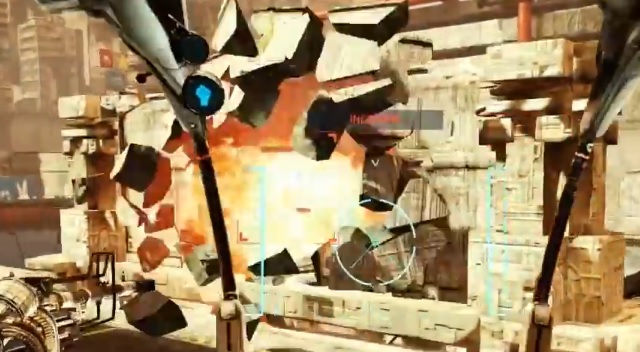
VisualFX – The focus here is on realistic effects to provide a more dynamic gaming experience. To ensure that game developers can quickly use them, most features have been integrated into a special UE4 branch, and we are working on integrating the remaining ones.
VXGI – This is all about global illumination, which has been a hard problem to solve in real-time. We are using an algorithm known as Voxel Cone Tracing. Global illumination computes all lighting in the scene, including secondary reflections of light of diffuse and specular surfaces. Adding global illumination to the scene greatly improves the realism of the rendered images. We integrated an early version into a special UE4 branch and have received great feedback. 
HairWorks – Fur and hair aren’t minor details; when it doesn’t look right, you notice it. From the very beginning, our focus with HairWorks was to ensure a great artist pipeline. We spend a lot of time creating the right feature set and easy to use tools. The result - HairWorks has been used in Call of Duty: Ghost, FarCry 4, Monster Hunter Online Benchmark, King of Wushu, and The Witcher 3. 
Turf Effects – Our grass technology creates a fully geometrical representation. The rendering supports natural shading with correct shadows from the individual blades of grass as well as self-shadows. The simulation supports interaction with highly complex shapes, which permits new gameplay features. We’re building this relatively new technology into our special UE4 branch to put it into the hands of more developers. 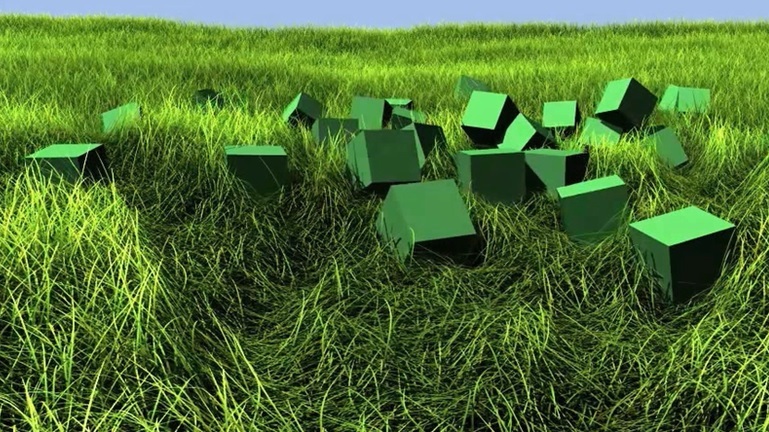
WaveWorks – This technology delivers cinematic-quality ocean simulation for waterborne action. Look for it in upcoming games, including War Thunder. We’ve also gotten inquiries from maritime simulation companies, who want to use our software to improve the realism of their products. 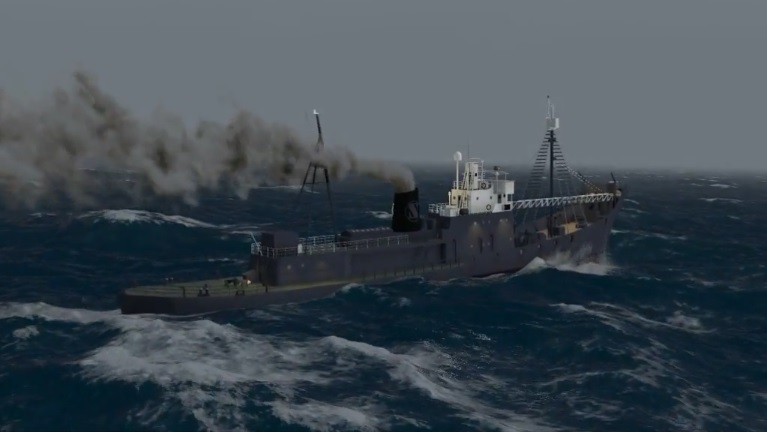
FlameWorks – This is just what it sounds like - a system for generating realistic fire, smoke and explosion effects. It combines a state-of-the-art grid-based fluid simulator with an efficient volume rendering engine. The library can also be used for energy-based spell effects using volumetric rendering. We’ve had several inquiries from the film industry for this technology. 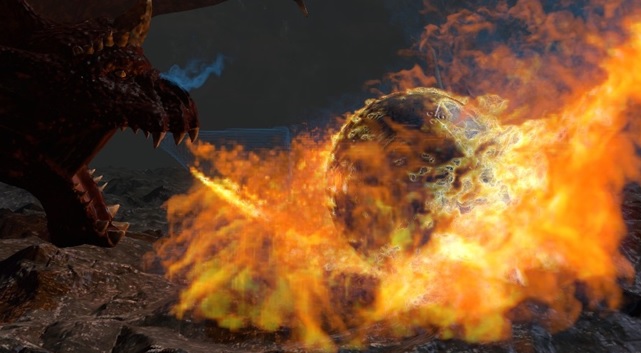
Advanced Soft Shadows (PCSS) – Go outside and look around and you’ll notice that the further a shadow is from the object that it is casting the shadow on, the softer the shadow is. Advanced soft shadows mirror this phenomenon to create more natural looking shadows in games such as Assassin’s Creed 4 Black Flag, Far Cry 4 and GTA V. 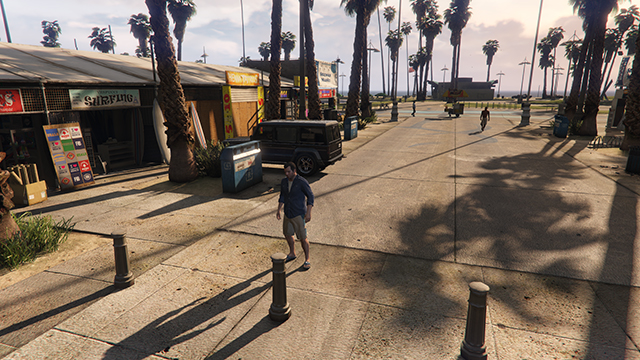
HBAO+ (ambient occlusion) – Nvidia has invested many hours optimizing the algorithms used to make the way scenes are lit more realistic. HBAO+improves upon existing Ambient Occlusion techniques to add richer, more detailed, more realistic shadows around objects that occlude rays of light. HBAO+ has been used in many games, from Call of Duty: Ghosts, TitanFall, Assassin’s Creed Unity to The Witcher 3. We integrated HBAO+ into a special branch of UE4 and are also providing a Unity plug-in. 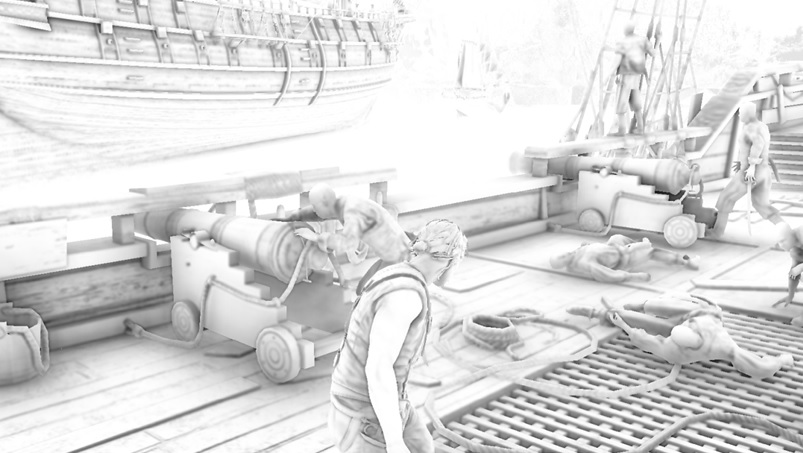
NVIDIA Developer Tools -- This collection of applications spanning desktop and mobile tools enables developers to build, debug and profile class leading and cutting-edge software which utilizes the latest visual computing hardware from NVIDIA.
NVIDIA Nsight Visual Studio Edition – Nsight brings GPU Computing into Microsoft Visual Studio and allows developers to debug, profile and trace heterogeneous compute and graphics applications using CUDA C/C++, OpenCL, DirectCompute, Direct3D, and OpenGL. 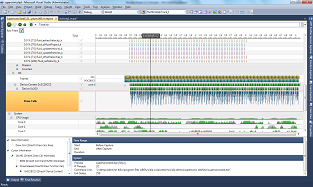
NVIDIA AndroidWorks – AndroidWorks installs all software tools required to develop for Android and reduces the complex process of configuring an Android development system down to a single click. Based on our Tegra Android Developer Pack (TADP), AndroidWorks is a professional grade solution designed to provide the best development platform for all Android devices - not only Tegra powered devices. 
NVIDIA Nsight Tegra, Visual Studio Edition – Nsight Tegra brings the raw development power and efficiency of Microsoft Visual Studio to Android, giving you the right tools for the job. Flexible project management, accelerated compilation and integrated debugging, no need to massage makefiles and shell scripts, no voodoo magic or arcane incantations required. 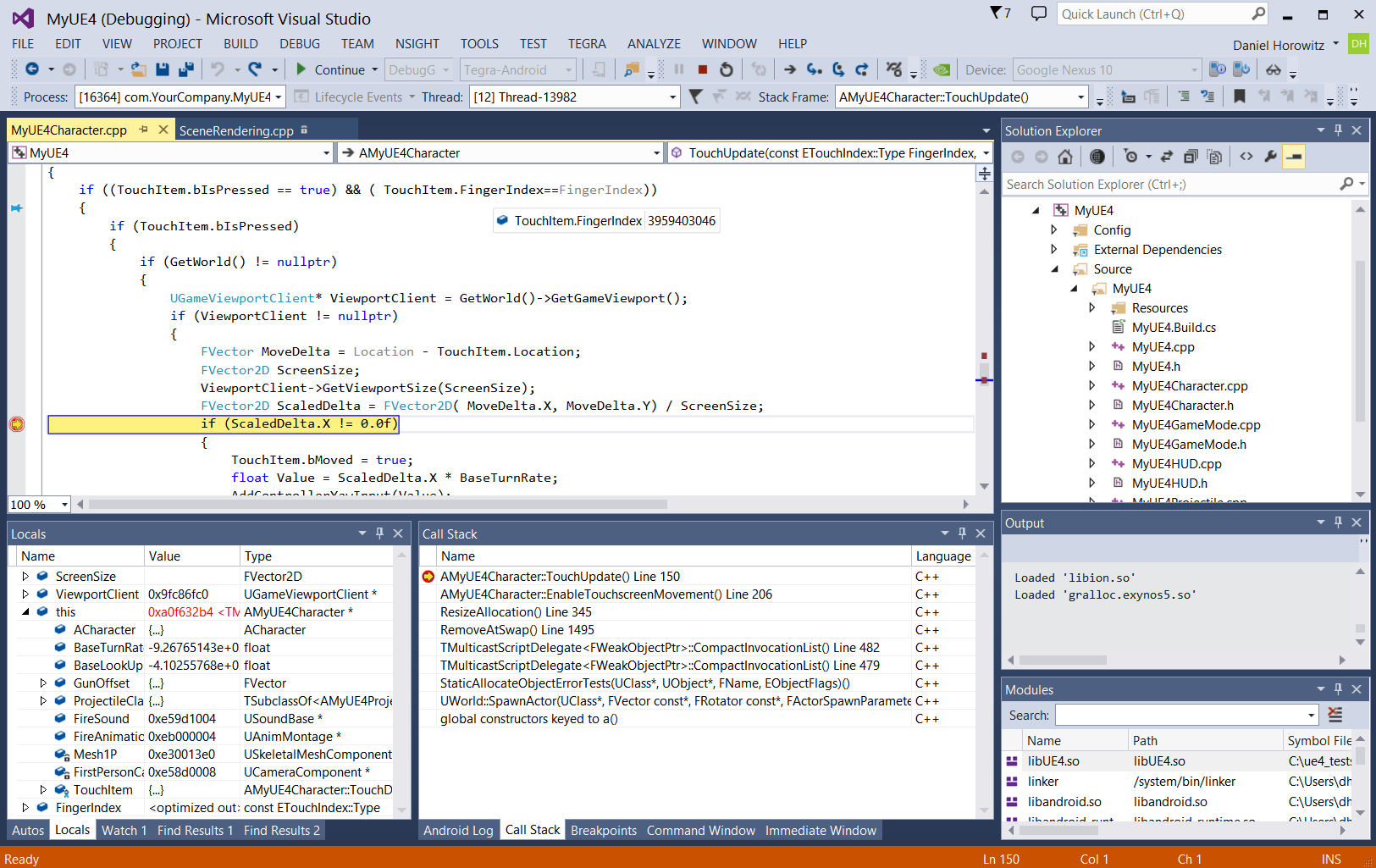
Tegra Graphics Debugger – Graphics Debugging and Profiling for Tegra K1. Tegra Graphics Debugger is a console-grade tool that allows developers to debug and profile OpenGL ES 2.0, OpenGL ES 3.0, and OpenGL 4.x on Windows, OSX and Linux enabling game and graphics developers to get the most out of Tegra K1. 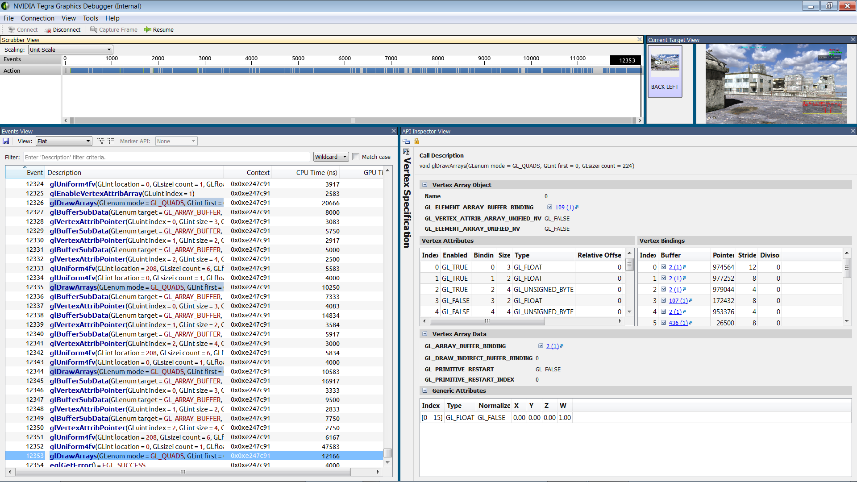
Tegra System Profiler – Tegra System Profiler is a multi-core CPU sampling profiler that provides an interactive view of captured profiling data, helping improve overall application performance. Available on Windows, Linux, or MacOSX host platforms and Tegra-based target platforms. 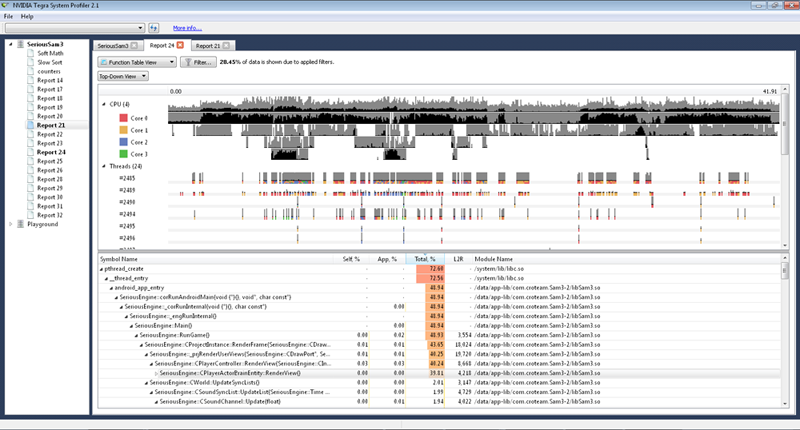
NVIDIA PerfKit – NVIDIA PerfKit is a comprehensive suite of performance tools to help debug and profile OpenGL and Direct3D applications. It provides access to low-level performance counters inside the driver and hardware counters inside the GPU itself. The counters can be used to determine exactly how the application is using the GPU, identify performance issues, and confirm that performance problems have been resolved. 
In addition to Developer Tools we provide authoring tools, such as the PhysX plug-ins for 3DS Max and Maya which support PhysX Clothing and PhysXLab, which is a standalone tool for PhysX Destruction.
Code Samples – We have released several graphic and compute samples to show users how they can best put in place different features. Both DirectX and OpenGL graphics samples (including OpenGL ES) focus on advanced features such as anti-aliasing, tessellation, interleaved rendering, deferred contexts, compute shaders and instancing. The samples run from a single source base on Windows, Android, Linux desktop and Linux 4 Tegra.
OpenGL Samples – Includes samples for Blended Antialiasing, Cascaded Shadow Mapping, Conservative Rasterization, Normal-Blended Decal, Weighted, Blended, Order-independent Transparency, Particles, Water Surface, FXAA, HDR, Instanced Tessellation, Motion Blur, and more. The OpenGL samples include source for a simple cross-platform application framework which forms the basis of all the samples. 
DirectX Samples – Includes samples for Antialiased Deferred Rendering, Advanced Motion Blur, FXAA, Deinterleaved Texturing, Compute Filter, Soft Shadows, and more. 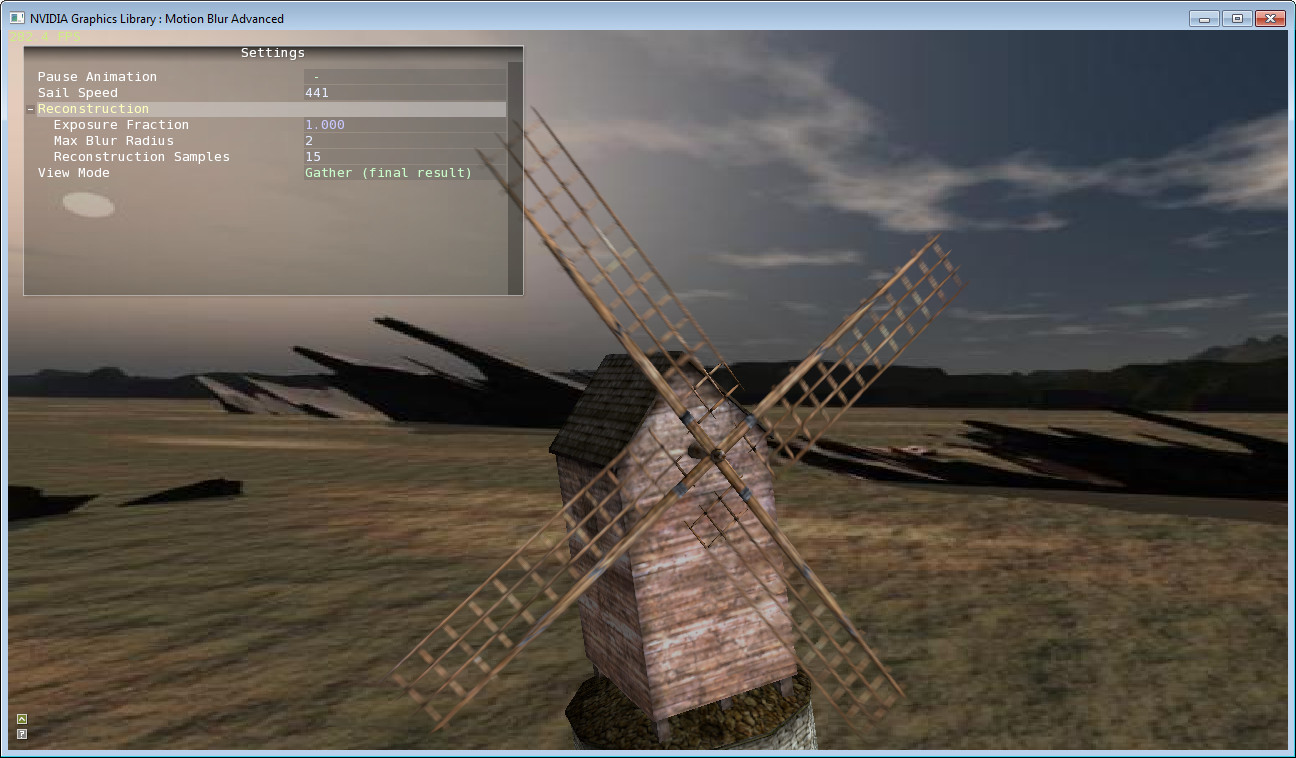
Research/People – Our research team is working on leading edge visual effects and has published several papers at Siggraph, GTC and other conferences. The research topics span a wide range of technologies including large scale fluid simulations, strain based dynamics, unified particle physics, voxel based global illumination, and real time multi-layered clothing simulation.
Fast Grid-Free Surface Tracking – We present a novel explicit surface tracking method. Its main advantage over existing approaches is the fact that it is both completely grid-free and fast which makes it ideal for the use in large unbounded domains. A further advantage is that it's running time is less sensitive to temporal variations of the input mesh than existing approaches. 
Air Meshes for Robust Collision Handling – We propose a new method for both collision detection and collision response geared towards handling complex deformable objects in close contact. Our method does not miss collision events between time steps and solves the challenging problem of untangling auto-matically and robustly. It is conceptually simple and straight forward to parallelize due to the regularity of the algorithm. 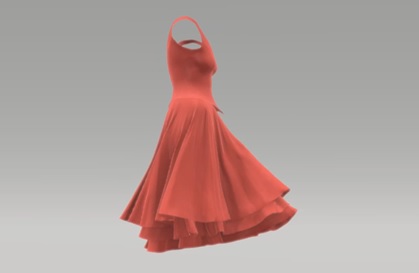
Unified Particle Physics for Real-Time Applications – We present a unified dynamics framework for real-time visual effects. Using particles connected by constraints as our fundamental building block allows us to treat contact and collisions in a unified manner, and we show how this representation is flexible enough to model gases, liquids, deformable solids, rigid bodies and cloth with two-way interactions. 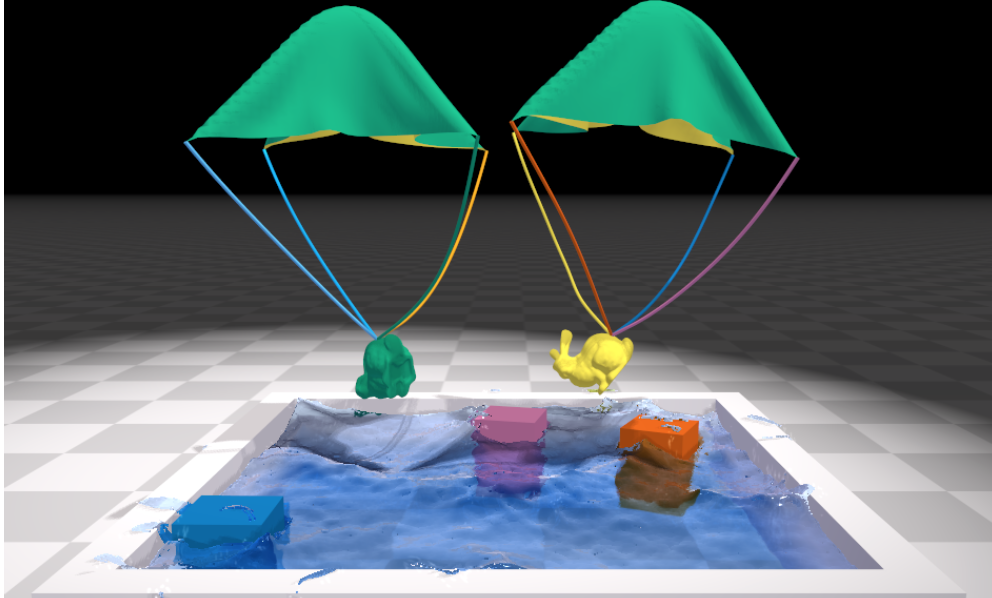
People. Tools. Technologies. In short, that’s GameWorks. It’s a program that’s more than the sum of its parts. Our unified GPU physics solver FleX is a great example for that. FleX is a particle based simulation technique for real-time visual effects that we created based on cutting-edge research. It’s using one unified solver for different simulated substances that can interact with each other. With FlexX we’ve built a tool that can bring this to gaming – and our team is working with developers to make this happen. The result: FleX will use the power of GPUs to create effects which before were only possible through offline applications.
https://developer.nvidia.com/content/what-gameworks
-
15-12-15, 15:54 #15Tech Ubër-Dominus


- Registo
- Nov 2013
- Local
- City 17
- Posts
- 30,121
- Likes (Dados)
- 0
- Likes (Recebidos)
- 2
- Avaliação
- 1 (100%)
- Mentioned
- 0 Post(s)
- Tagged
- 0 Thread(s)
AMD’s Answer To Nvidia’s GameWorks, GPUOpen Announced – Open Source Tools, Graphics Effects, Libraries And SDKs
As you read this AMD will have officially announced GPUOpen, a platform that delivers open source tools, graphics effects, libraries and SDKs. GPUOpen is AMD’s initiative to offer developers support with a robust set of tools and resources to extract the most out of GPUs for both gaming and compute applications. It enables game developers to create more beautiful, complex and immersive game worlds. And facilitates the employment of the powerful parallel engines inside modern GPUs for computation. All under a cohesive and easily accessible open source umbrella.



We’ve detailed what GPUOpen is and what exactly AMD is offering with this new program to developers globally in a separate article which you can find here. In this article we’re going to talk more about what this program means to you as a developer or a PC gamer and how it may represent the crucial step that the PC gaming industry has been missing to drive innovation in a way that benefits everyone involved and move the entire industry forward.
Both Sides Of The Coin, Nvidia’s & AMD’s Industry Catalysts
To really understand what GPUOpen is and why it matters we have to go back to a program called GameWorks that Nvidia introduced a while back.
What GameWorks Is And Why It Exists
GameWorks is a developer program set-up by Nvidia to provide game developers with a collection of graphics libraries and tools aimed at improving the visual quality of games. It includes technologies such as PhysX – Nvidia’s proprietary physics engine – as well as VisualFX which encompasses a number of Nvidia optimized rendering techniques and in-game visual effects. These include things like shadows, anti-aliasing, depth of field, global illumination, hair simulation, ambient occlusion, lighting and other effects.
Below you will find the VisualFX solutions as listed on Nvidia’s website.
VisualFX provides solutions for rendering and effects including:
- HBAO+ Enhanced Horizon Based Ambient Occlusion
- TXAA Temporal Anti-aliasing
- Soft Shadows Improves on PCSS to reach new levels of quality and performance, with the ability to render cascaded shadow maps
- Depth of Field Combination of diffusion based DOF and a fixed cost constant size bokeh effect
- FaceWorks Library for implementing high-quality skin and eye shading
- WaveWorks Cinematic-quality ocean simulation for interactive applications
- HairWorks Enabling simulation and rendering of fur, hair and anything with fibers
- GI Works Adding Global Illumination greatly improves the realism of the rendered image
- Turbulence High definition smoke and fog with physical interaction as well as supernatural effects
Nvidia told us about several motivations which formed the primary driving force behind the development of the GameWorks program. For starters the program would allow the company to both widen its scope of reach and speed up the adoption rate of its technologies. The company had grown frustrated from how slowly things moved and it had to accelerate the turnover of its investment in this field. Faster and wider adoption means that more games can leverage more of Nvidia’s tech. This in turn translates to the creation of more games where the company can positively influence the visuals to offer users of its latest GeForce products a better experience.
This in turn gives Nvidia a more authoritative say in how the feature runs and looks in the game, after all it is its intellectual property and perhaps more importantly it gives the company a competitive advantage by which it can justify its investment.

By offering developers the convenience of an easy to integrate dynamically linked library – essentially a middleware solution – that’s already optimized for Nvidia’s hardware, it can cut back tremendously on the development time and allow game developers to dedicate their resources to focus on other areas in their games.
it’s still important to note that the initial introduction of GameWorks as a middleware solution was a subject of staunch criticism by the PC gaming community and numerous big names in the game development world, some of which went as far as to label GameWorks an “unusable blackbox”. Several issues were brought up around licensing, accessibility to source code and the developer’s ability to optimize for different, competing, hardware.
Nvidia has since made changes to its policies in response to requests from the game development community. We published a four thousand word in-depth investigative report about GameWorks earlier this year that I’d urge you to check out if you’re interested in understanding both Nvidia & AMD sides of the GameWorks story.
Advertisements
However in the end there were several issues rooted in the principle that were simply insurmountable. One hardware vendor providing a proprietary middleware solution which influences the visuals and performance of the game developer’s product as well as competing hardware was always going to result in some form of bias even if unintentional and that’s where GPUOpen comes in.
GPUOpen A Comprehensive Open Source Solution
GPUOpen delivers a comprehensive approach to improving both gaming and compute in an industry wide approach that not only serves the Windows and DirectX ecosystem but also extends these benefits to Linux. All accessible from the GPUOpen portal on GitHub.


It’s important to talk about what open source means in this context because it’s been a subject that had come under a lot of scrutiny in the past.
For example back in 2013 AMD introduced TressFX Hair which is the first hair physics and simulation technology of its kind to be implemented into a game. TressFX Hair as well as almost all of the visual effects developed by AMD are made available publicly for anyone to download and use on AMD’s developer website under a non-exclusive, non-transferable, royalty-free, limited copyright license.
 AMD Developer Website
AMD Developer Website
Because these features are not packaged as a middleware solution they are integrated directly into games, so developers have full access to the source code to work with it and adjust it as they see fit. And this included a variety of effects such as soft shadows, high definition ambient occlusion, various techniques for anti aliasing, hair simulation global illumination and other effects.

GPUOpen takes one step further for the sake of openness and adopts a model and a license that’s even more lenient. The license in question is MIT’s open source license where everything can be used without restriction. Not only that but it also allows the assets to be altered, or improved and then sold for profit by any entity. This in turn gives a myriad of incentives to all kinds of independent developers, larger studios and even visual computing companies to actively participate in the initiative

In many ways then GPUOpen tries to address the same industry challenges as GameWorks, but does so in a more cohesive and collaborative effort that allows the industry to move forward as a whole and where small contributions can come together to create something more effective, more exciting and more impactful than what each individual company can ever hope to achieve.
AMD is launching the GPUOpen platform this January with variety of effects, tools and SDKs planned, including : TressFX 3.0, GeometryFX, AOFX — Ambient Occlusion–, ShadowFX, LiquidVR SDK, DirectX 11 and 12 code samples, compute tools, and several other SDKs.

















Informação da Thread
Users Browsing this Thread
Estão neste momento 1 users a ver esta thread. (0 membros e 1 visitantes)





 Responder com Citação
Responder com Citação








Bookmarks